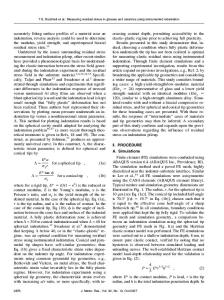Analytical and experimental resolutions in the duality of mechanical property extractions from instrumented indentation
- PDF / 192,495 Bytes
- 7 Pages / 585 x 783 pts Page_size
- 83 Downloads / 365 Views
aláa) Department of Materials Science and Metallurgical Engineering, Escola Tècnica Superior d’ Enginyeria Industrial de Barcelona (E.T.S.E.I.B.), Universitat Politècnica de Catalunya, Barcelona 08028, Spain; and Faculty of Aerospace Engineering, Technion (Israel Institute of Technology), Haifa 32000, Israel (Received 19 October 2006; accepted 25 January 2007)
A controversial issue in mechanical property extractions from instrumented indentation applied load (P)–penetration depth (hs) curves concerns the possibility of finding more than one solid that essentially exhibits the same contact response. By recourse to finite element simulations of elastic-power law strain hardening solids, it was shown that for both the elasto-plastic and the fully plastic contact regimes it becomes possible to find an arbitrary number of solids whose P-hs curves are visually similar [L. Wang and S.I. Rokhlin, J. Mater. Res. 21, 995 (2006)]. Although this assertion supports prior findings [e.g., C.M. Cheng and Y.T. Cheng, J. Mater. Res. 14, 3493 (1999); K.K. Tho et al., Mater. Sci. Eng. A 390, 202 (2005); and J. Alkorta et al., J. Mater. Res. 20, 432 (2005)], it apparently contradicts the work by Casals and Alcalá in which, through similar computational procedures and constitutive theory, it was shown that there can be “only” two solids with strictly the same P-hs curve [O. Casals and J. Alcalá, Acta Mater. 53, 3545 (2005)]. The purpose of this comment is to reconcile the different views on the multiplicity of inferred properties that can be extracted from a single P-hs curve, as well as to address the issue of whether visually similar P-hs curves can be taken to be statistically identical both from analytical and experimental standpoints. Some considerations are also given regarding experiments performed with dual indenters. I. GENERAL FRAMEWORK AND COMPARISON 1 of Ref. 1.) This relation is also central in the work by BETWEEN VARIOUS INVESTIGATIONS Wang and Rokhlin,2 as it enables extraction of n from the experimentally measured values of hr/hmax and he/hmax. We initiate this discussion by summarizing that the In Ref. 1, we deliberately choose to correlate variables strict duality in mechanical property extractions is based /h h r max and he/hmax with n through a multiplication of in Ref. 1 upon the relationship between penetration depth dimensionless functions involving hardness p¯ and surratios hr/hmax and he/hmax, measured in an instrumented face deformation parameter ␣. That is, indentation experiment, and uniaxial strain hardening coefficient n. (Following the conventional contact variables used in describing the P-hs curves, residual penetration depth hr, linearly extrapolated penetration depth he, and maximum penetration depth hmax, are all depicted in Fig.
⌶21⭈⌶2 ≡
兿 冉h 8
where a)
Address all correspondence to this author. e-mail: [email protected] DOI: 10.1557/JMR.2007.0182 1138 J. Mater. Res., Vol. 22, No. 5, May 2007 http://journals.cambridge.org Downloaded: 18 Mar 2015
⌶1
hr
max
冉
冊 冉
1−
冊
,
,n =
1
2
f
hr
Data Loading...










